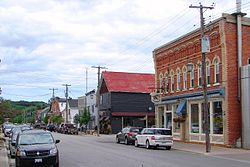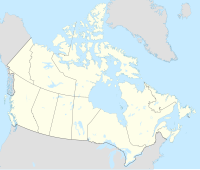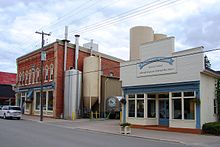| This article needs additional citations for verification. Please help improve this article by adding citations to reliable sources. Unsourced material may be challenged and removed. Find sources: "Creemore" – news · newspapers · books · scholar · JSTOR (December 2020) (Learn how and when to remove this message) |
| Creemore | |
|---|---|
 | |
  | |
| Coordinates: 44°19′N 80°06′W / 44.317°N 80.100°W / 44.317; -80.100 | |
| Country | Canada |
| Province | Ontario |
| County | Simcoe |
| Municipality | Clearview |
| Government | |
| • Mayor | Doug Measures |
| • MP | Terry Dowdall (C) |
| • MPP | Brian Saunderson (PC) |
| Area | |
| • Total | 1.59 km (0.61 sq mi) |
| Population | |
| • Total | 1,194 |
| • Density | 750.8/km (1,945/sq mi) |
| Time zone | UTC−05:00 (EST) |
| • Summer (DST) | UTC−04:00 (EDT) |
| Postal code | L0M |
Creemore (from Irish Croí Mór 'big heart') is a former village, now part of Clearview Township, located in Simcoe County, Ontario, Canada. It lies approximately 130 km (81 mi) north of Toronto, 40 minutes west of Barrie, and 20 minutes south of Collingwood and Georgian Bay. It sits on the eastern boundary of the Niagara Escarpment.
Creemore purportedly has North America's smallest jail. Coboconk and Tweed make similar claims of their jails.
History
French explorer Samuel de Champlain first visited the Creemore area in 1616 to promote trade with the Petun, a First Nations tribe. He was the first to write a description of the area: “The country is full of hill-slopes and little level stretches, which make it a pleasant country.’
Before explorers arrived in the early 17th century, indigenous people lived in the general area of Creemore. Some of these native tribes included: Petun, Wyandot (Wendat), Iroquois, and Algonquin. Soon, early white explorers arrived to trade with these native tribes. Along with the arrival of the explorers, English civilization was soon imported into the area that we now know as Creemore. The settlement of Creemore began in 1842, and by the turn of the century it was a thriving village of about 800 people with a vibrant business community.
Creemore's name and town origins have strong Irish roots – the name is derived from the Irish “cron mor,” which means “big heart” and it was the village's founder, Irish entrepreneur Edward Webster who coined the name in the year 1845. He paid tribute to his family by naming the original streets after them: Elizabeth (for his wife and daughter), Francis and Wellington (for his sons), and Alice and William (for his parents).
In 1993, the amalgamation of Sunnidale, Nottawasaga, Village of Creemore and the Town of Stayner took place and it became Clearview Township.
Economy

Creemore has a vibrant small business community and is the home to Creemore Springs Brewery. The microbrewery was acquired by Molson on April 22, 2005. Each year the Copper Kettle festival attracts thousands, closing the entire main street with activities and antique automobile displays, bands, Farm animals and many other attractions for young and old.
References
- ^ "Census Profile". 2021 Census. Statistics Canada.
- "About Us". Archived from the original on 2010-04-07. Retrieved 2010-03-10.
| Simcoe County, Ontario | |
|---|---|
| Cities | |
| Towns | |
| Townships | |
| Unincorporated communities | |
| First Nations | |
| Indian reserves | |
Separated municipalities but remain a census subdivision of the county | |